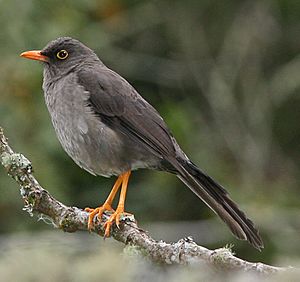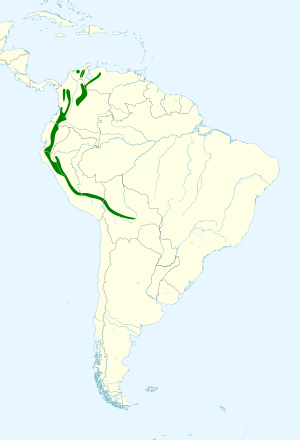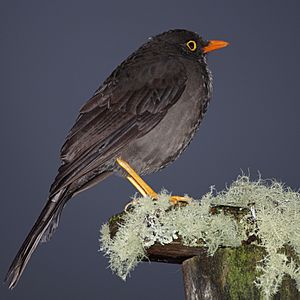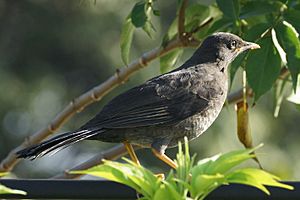Great thrush facts for kids
Quick facts for kids Great thrush |
|
|---|---|
 |
|
| Male | |
| Conservation status | |
| Scientific classification | |
| Genus: |
Turdus
|
| Species: |
fuscater
|
 |
|
The great thrush (Turdus fuscater) is a type of bird that belongs to the Turdidae family. It lives in several South American countries like Bolivia, Colombia, Ecuador, Peru, and Venezuela. This bird is known as the biggest thrush in South America. Its large size helps tell it apart from other gray-colored thrushes in the same areas. The great thrush lives in wet, tropical montane forests and high-up shrubland. But it can also be found in areas where forests have been changed, and even in cities.
Contents
What the Great Thrush Looks Like
Adult great thrushes are about 28 to 33 centimeters (11 to 13 inches) long. They usually weigh around 141 grams (5 ounces). This makes them one of the largest birds in the Turdus group. You can easily spot them by their yellowish-orange beak and legs, and the bright yellow ring around their eyes.
Sometimes, male and female great thrushes look a little different. Males might have brighter colored legs and eye rings. Their tail feathers are long. The bird's body is black-brown, with darker wings and tail, and a lighter belly. Young great thrushes are mostly greenish-gray with a pale belly and some light spots on their head and wings. Very rarely, some great thrushes can be albino, meaning they are all white.
Where Great Thrushes Live
The great thrush is a bird that typically lives in the high Andes mountains. You can find it in western and northern Venezuela, throughout the Andes in Colombia, Ecuador, Peru, and into northwest Bolivia. These birds usually live at heights between 1,800 and 4,000 meters (about 5,900 to 13,100 feet) above sea level.
Great thrushes can live in many different places. This includes open forests, backyards, parks, and even farms with scattered trees. They also live at the edges of different kinds of Andean forests, like wet mountain forests. They are more often found at higher altitudes, usually above 2,000 meters (about 6,500 feet). These birds tend to stay away from very dry places or very thick forests. However, they can sometimes be found at the edges of Andean páramo (a type of grassland) or in shrublands. They are common in cities in the highlands, such as Quito and Bogota. Most great thrushes do not move far from their homes.
What They Eat and How They Live
The great thrush eats many different things. They mostly look for fruits and berries, but they also eat small creatures without backbones, like insects. Sometimes, they even steal eggs and baby birds from other nests! They usually swallow fruits whole. These birds often look for food on the ground, especially in short grass. But they also visit trees and bushes that have fruit. They are most active early in the morning and late in the evening. If they get scared and fly away, they usually don't fly very far.
Adult great thrushes become very protective of their space during the breeding season. But at other times of the year, they can form groups of up to 40 birds. These groups might gather together in trees until it's time to breed again.
Reproduction and Family Life
Great thrushes lay eggs at different times of the year, depending on where they live. For example, in Venezuela, it's in March and April. In Colombia, it's from January to August. In Ecuador, it's in October, and in Peru, it's in February and June.
Their nest is quite large and shaped like a cup. They build it from small twigs, leaves, grass, and mud. The nest is usually placed low in trees or bushes. The female bird lays two eggs. These eggs are a pale blue-green color with reddish spots and are about 2 centimeters (0.8 inches) long.
Songs and Sounds
The great thrush makes many different sounds. Their song is soft and musical. They only sing during the breeding season, just before the sun comes up. Their song has quick, varied musical parts that end with a very high note. If they are scared or surprised, they make a short "keert" sound or a series of "kurt-kurt-kurt-kurt" sounds. They can also make a loud "kweep" sound.
How We Protect Them
The great thrush is a common bird found in many different places across its wide home range. Because of this, the IUCN (International Union for Conservation of Nature) has listed it as a species of "Least Concern". This means they are not currently at risk of disappearing. The great thrush can easily get used to changes made by humans, and it can live in cities, deforested areas, or farmlands.
See also
 In Spanish: Paraulata morera para niños
In Spanish: Paraulata morera para niños




